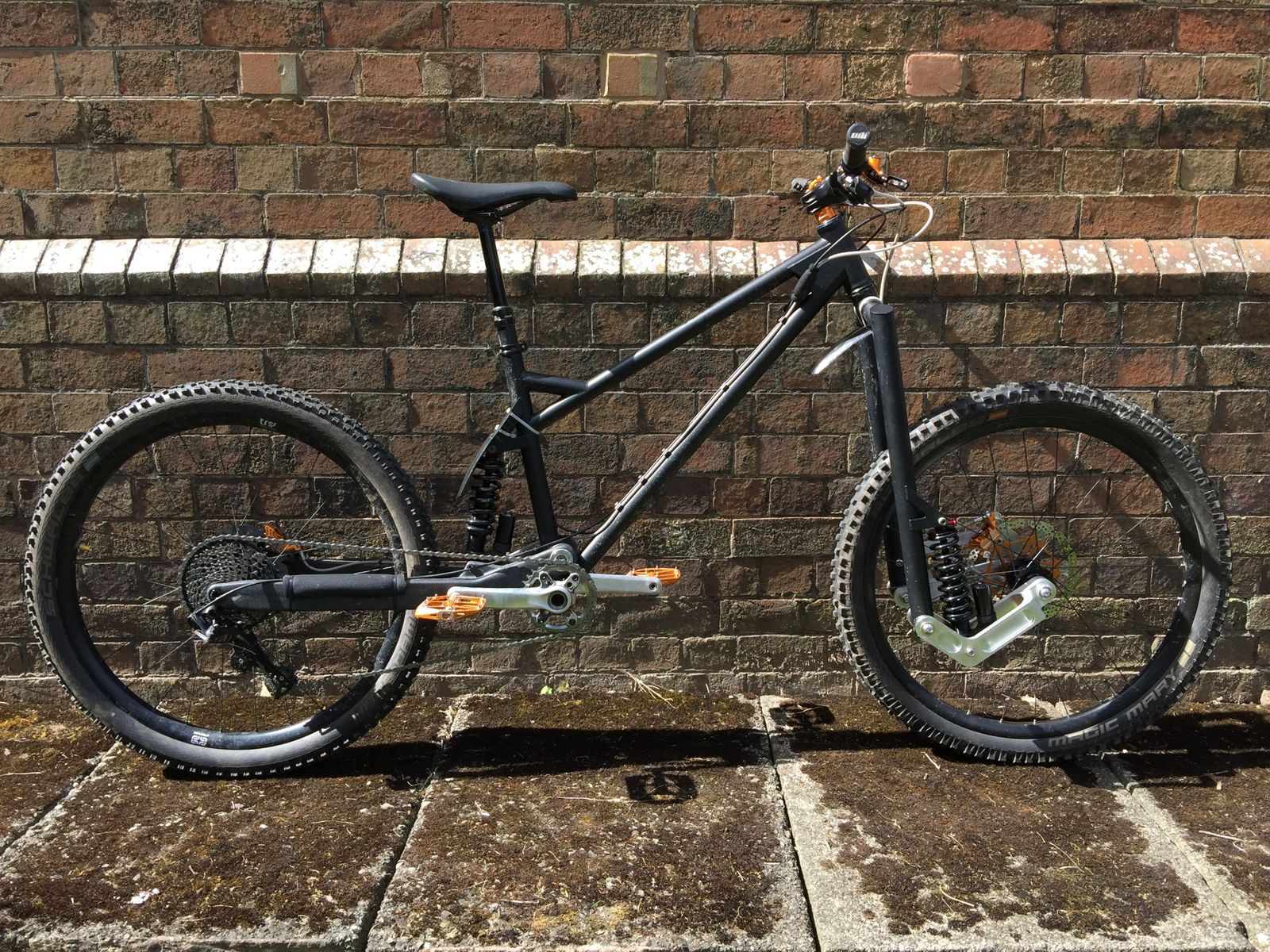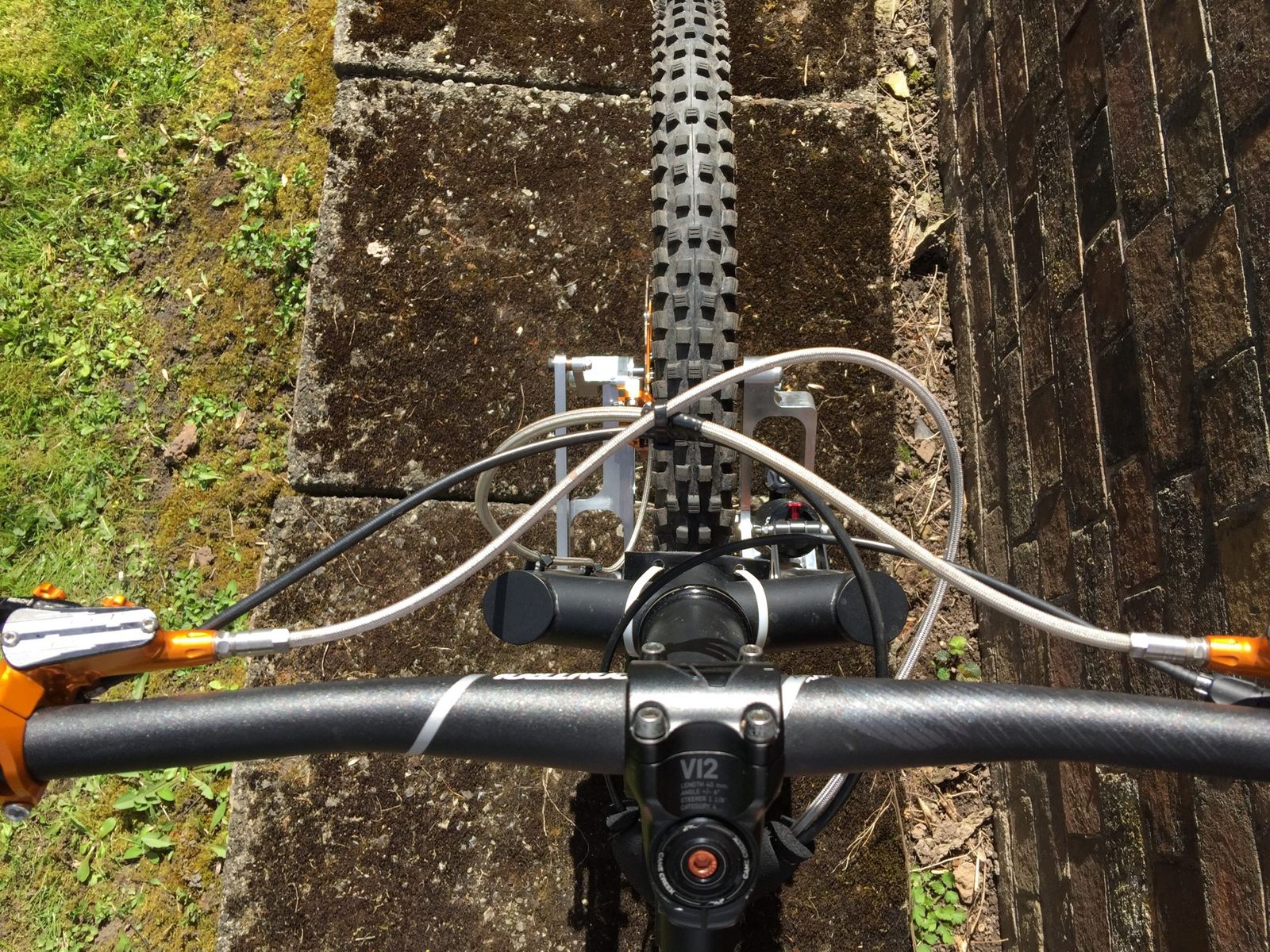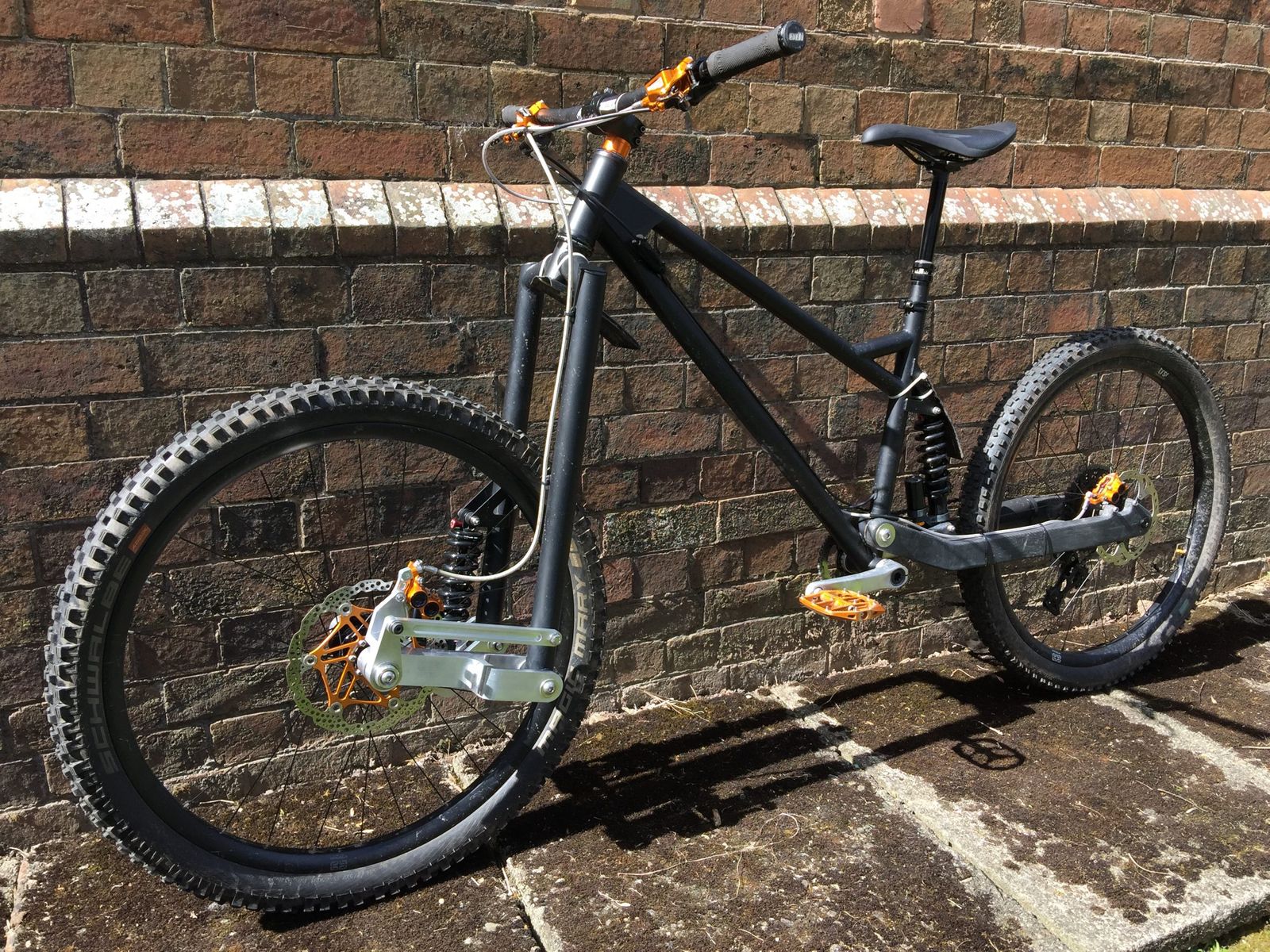There are few things that please me more than spotting a curious bike being built by someone and getting to ask them about it. Unlike some that I’ve seen, this creation from Rocksled Suspension doesn’t strike me as beautiful, or as a piece of technically skilled hand craft work – this is more of a mathematical curiosity, or a science experiment. And unlike others I don’t feel compelled to stroke it or touch it – I’m a little scared it would bite me. But curious it is, and so I set about tracking down its designer to find out why this beast exists.

First of all: who are you and what’s your background with bike design – have you been taught to do this, or are you a shed-school genius?
My name is Ashley Kalym, no background in bike design other than what I have picked up over the last few years. I basically read as much as possible, reached out to a few people online, and perused a few forums for a general understanding of things. The bike and the fork are the first forays into bike building, but I knew how to use CAD from a few years before, self taught of course.
I wouldn’t say I’m a shed-school genius in any way! The fork has the potential to be inherently better than any telescopic fork, not because of my engineering smarts, but simply because bearings will always win out over bushings and seals. The physical layout of linkage forks has a huge inherent advantage over the telescopic design; I just think that more work needs to be done refining the idea and making it as simple as possible.
Latest Singletrack Merch
Buying and wearing our sustainable merch is another great way to support Singletrack
Starting with the carbon fork – because I think you did too – what made you go for a carbon lefty linkage fork?! Was it the freak factor, or something a little more functional?
I knew Adrian from Carbon Wasp as I had been exploring some other things before the fork, and decided that it would be simpler and easier to do a single sided fork for the first version. I went for the simplest, easiest, and cheapest route (with my limited fabrication skills), as I just needed to see whether it was possible to use a normal off the shelf shock in place of a telescopic fork.
Yes, it was basically purely functional, as the second version of the fork and first version of the frame are. I tried to pursue performance and nothing else, with a few caveats of course, like not being too worried about weight, and not being too worried about aesthetics.
I think it took you a while to get from design to actual object – was that just life in the way, or design challenges? What took the most figuring out to get right?
Yeah it did, but it was mostly work/life/family/time constraints, rather than any engineering problems. The linkage, frame and fork, and swingarm all came from different places, so there was also some queue waiting and so on, for build slots to open up. The frame was actually easy, as it is the simplest possible suspension system really, and is pretty much a geometry mule to see how the front centre/rear centre ratio felt.
For the fork, the most difficult thing was the packaging, and getting everything to fit. I wanted to be able to use a normal coil shock in there (or any shock really), so needed enough space for piggybacks, dials, levers, etc. The actual 2 dimensional design came together very quickly in my CAD program, as I went in knowing exactly what it was I wanted to design.
Having ridden it, do you think you did get it right?! What led you to design the next fork differently?
The fork works better than I could have hoped. Super plush, very sensitive to small bumps, and there’s almost no stiction. The progressive leverage curve feels good, and the dynamic offset should help (on paper). I do need to up the spring rate slightly, and get a different shock tune to speed the rebound up as it is much too slow, even wide open.
This version of the fork was simply an evolution version 1. I didn’t like the amount of anti dive V1 had, so decided to fully float the brake calliper for this one. I also wanted to make it two sided for more strength and stiffness, and to try out steel as a material to compare the qualities of both.
How many iterations of fork have you now done? What has been the goal with each?
This is the second version of the fork I have built, with a third nearing completion in my CAD program. The goal of the first version was to simply get it working, with the fewest possible parts. Second version was to refine the idea more, get rid of the anti dive, and increase the travel to 180mm instead of 160mm. Third version will be to reduce the weight of the linkage, move to a 15mm axle to make it more compatible with what most people run these days, and try and reduce the axle to crown height slightly to get it in line with all of the other forks on the market.
You’ve now gone the whole hog and designed a bike too! Is this fork designed specifically for this frame, or could it go on any frame – like the Geometron you had the lefty on?
No, it wasn’t designed for this frame specifically. It’s set at 180mm now (230mm x 65mm shock), but swapping the shock out for a different stroke length takes the travel down to 170mm and 160mm. The axle to crown height is quite high (590mm or so), but it uses a standard steerer tube, and the offset is 45mm at 0mm travel.
Why make a frame too? What were you hoping to achieve with your bike design that you couldn’t just buy elsewhere?
I had been thinking about longer chainstays for a while, and had read a few forum posts and watched a few videos where guys talked about front centre to rear centre ratios (Steve from Vorspung Suspension has a good one), and decided to try and design one around this idea. That was simply it; to get the front/rear centre ratio as close to 1.5:1 as possible. There was nothing really on the market even approaching this length chainstay, so the only solution really was to build it myself!
What bikes have you ridden that informed your design – have you taken inspiration from other bikes, or gone all your own way? What sort of riding did you have in mind when you were planning this bike?
I have only ridden a few over the last few years… A Canyon Sender, Canyon Strive, and then a Nicolai/Geometron G16. I noticed right away that the Sender felt much better and cornered more confidently in the longer chainstay setting, and that the Nicolai felt more stable than anything else due to the overall length of the wheelbase. One thing I didn’t like was that the Nicolai felt uncertain if lots of weight wasn’t put on the front wheel, so one way of correcting this is to either make the front centre shorter (by reducing the reach or steepening the head angle) or lengthening the chainstay. The type of riding I had in mind was enduro/downhill really. The geo means that it will never be as “playful” as a dirt jump bike, or even a normal trail bike.
Let’s have some numbers?
So travel front and rear is 180mm, using a 230mm x 65mm shock for the fork and a 210mm x 50mm shock for the rear. Head angle is 63 degrees, seat angle is 80 degrees, reach is 475mm, front centre is 840mm and chainstays are 560mm. This gives a FC:RC ratio of 1.5:1.
Leverage curve for the fork begins at 3.2 and ends at 2.4. Rear suspension is very linear, less than 5% or so, roughly 3.2 to 1. Anti squat sits around 90%, which is as good as I could get with the suspension setup I chose.
Focussing on the frame and rear suspension, what’s going on there? Why have you put the rear shock behind the seat tube? What’s the benefit?
It’s a very simple swingarm driven set-up, and the shock is behind the seat tube simply because there was room for it, and I could drive the shock using the swingarm in that layout. Probably not much benefit except for being able to fit water bottles inside the front triangle more easily, and having a lower standover height.
Were there any particular challenges in taking this from a CAD design to a reality?
No areas of the frame were particularly tricky. As everything is so stretched out at the back there was simply more room to fit everything in. Stiffness fore to aft is a slight issue, as the chainstays are so long there is just more leverage on the pivot. I have ideas for a second version of the frame that will be very out there in terms of suspension design (basically replicating the linkage from the fork on to the rear, with a gearbox, two chains, and a floating brake). But that is some way off yet, if it ever gets built.
You’ve had the frame built in steel – is that your material of choice, or just for ease of prototyping? Why did you get it made all the way out in Canada?!
It was lots of things really: I kept reading good things about steel as a material, the ride feel, moderate cost, ease of fabrication, ability to repair damage potentially, etc. I think I searched for “linkage fork” on Instagram one day, and Daam Built came up. Peter had designed his own linkage fork very similar to mine, but with 120 or 140mm travel I think? His work looked amazing, so I got in touch and went from there. I could’ve used any frame builder, but the fact the Peter had built and ridden his own linkage fork just made it an obvious decision.
Now you’ve ridden it, do you think you’ve got the frame and suspension layout right? What would you like to tweak or change?
Yeah I think I have. There are downsides of course; it isn’t the most playful bike, manuals are very difficult, and the shocks need tweaking a little to adjust the rebound speed/spring rates, but the overall geometry is great. The bottom bracket could be slightly higher, but I think my cranks are relatively long, so pedal strikes could be solved with 165mm cranks.
The bike as a whole – it does look pretty weird to the eyes of us accustomed to modern mountain bikes! Do your eyes and brain need to adjust to how the the front wheel looks on the trail too?
Yeah it looks weird for sure! But the only difference really in terms of where the contact points is the rear wheel. The offset of the fork, the reach, head angle, seat angle, etc., are all fairly normal, if a little rare to be seen together. No, on the trail it feels completely normal, as if you think about it, what part of the bike do you actually look at when riding? Most (if not all) people are looking a few yards down the trail, and don’t see the bike, or if they do it’s out of their peripheral vision.

Does the bike as a whole work better than the fork on its own?
I’m not sure yet. I think the fork is a more complete package, as it has a good leverage curve, and is a lot more thought out than the frame. The frame is much more of a geometry experiment, and so the suspension design is simple to keep the cost and complexity down. You can definitely tell that there is some pedal kickback as is usual with most designs, so the next version of the frame will use a jackshaft system to completely eliminate that.
It looks long, and like there’s a whole lot of action happening with the wheels when you’re rolling along – is that just an optical illusion? How is it on corners? What sort of terrain is it happiest on?
Yeah the wheelbase is 1400mm, so not many bikes out there that are longer! Not sure, it might be an optical illusion. The front wheel does move back and up, more or less in line with the head angle (like a regular fork) and the rear wheel moves more vertically because of the pivot location, so maybe that has something to do with it? But I’ve only had one ride as of writing this, so there are still a few things to sort suspension wise with regard to damping and spring rate, so that could be it. It’s also worth mentioning that the spring on the front is 350lb and the rear is 600lb, chosen from my calculations. But, it’s likely that the front is under sprung and the rear might be over sprung, but I’ll get this sorted over the next few weeks.
What’s next? And to what end – is this all just for curiosity’s sake or with the intention of getting a production bike at the end of it?
Yes, it was just for my own use really, with a 5% thought about production. I think the fork is much closer to that goal though, but it would need at least another version, and be tested to make sure that it would hold up under heavy use. I think that the fork certainly wouldn’t be for everyone, as it is hard to make it light enough (with a coil shock at least) to compare to current telescopic offerings, and the weird looks will put a large part of biking community off. Performance wise I think it is up there, especially with a decent shock, as any suspension system that runs on bearings is going to be less susceptible to binding and stiction.
The frame is very much still in a prototype stage. I’m convinced of the benefits of much longer chainstays (or I should probably say a more balanced front centre to rear centre ratio), but how popular this type of frame/bike would be with people is very unclear. Perhaps for racers or people who ride to be fast it might be popular, but for those who ride jumps, or session features, or want a more playful and involving bike, it wouldn’t be for them.

Thanks Ashley for taking the time to talk to us. What do you think? Is it just a curious experiment, or does it raise some interesting questions about where bike design might go?
Like this sort of thing and want to read more? Here you go:















Holy chainstay length batman! That’s an ‘interesting’ looking bike, to say the least, looks that only it’s mother could love
Very mono-shock MX design there at the rear. The carbon-fibre single sided fork looks like it may have leg(s) though.
Respect. Love it, particularly the what-if attitude towards starting from scratch and iterating.
The carbon version looks a lot like USE’s one-sided fork, which people actually seemed to like quite a lot when it worked. The front coilover thing gave me a bit of a Diamondback / Whyte flashback, in a PTSD sort of a way. 😀
The long rear end would not like some of the singletrack ’round these parts. But all this stuff has to be tried out – good on the designer for giving this stuff a whirl.
Too many things that just ask questions such as how susceptible is that fork to hits from rocks/roots/etc considering how low and wide it is, and the angles of it ask how it would cope with heavy landings or straight edge landings on jumps or gaps. The rear is just weird, longer chainstay by the looks of it added with a shock that’s completely exposed to the horror of a UK winter!
Looks very interesting – absolutely ugly, but it does also look absolutely functional…as much as it is looks sore on the eye, I’m liking it.
Classic tinkering ‘what if?’…fabulous. This guy needs to phone Alan Milyard and go for a ride.
Absolutely bonkers……! Interesting though. From the video, I can see the front wheel is landing the jump fine, then the front wheel rebounds a few times. Either the suspension needs tinkering with (rebound damping?), or the design doesn’t allow proper rebound damping and it makes for very sketchy front wheel ground tracking…….!! If I make sense (English is one of my foreign languages)….!